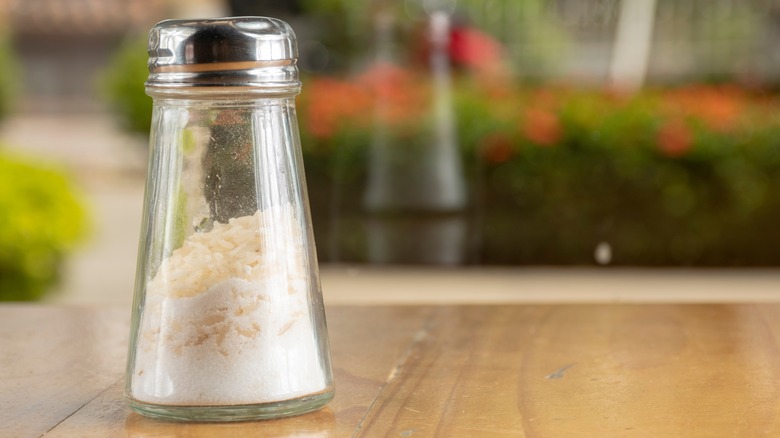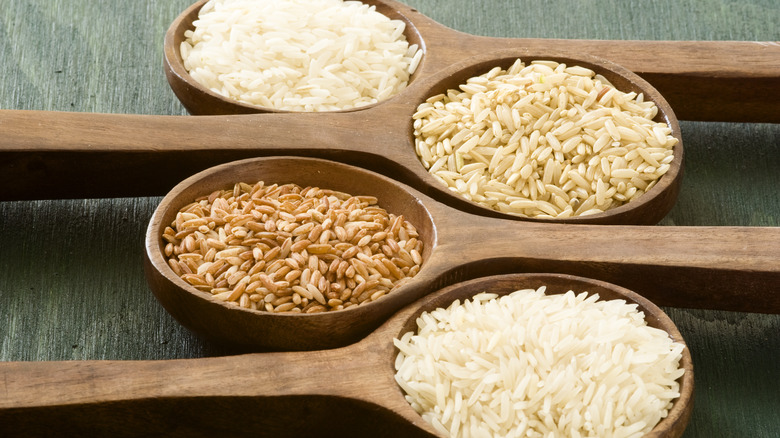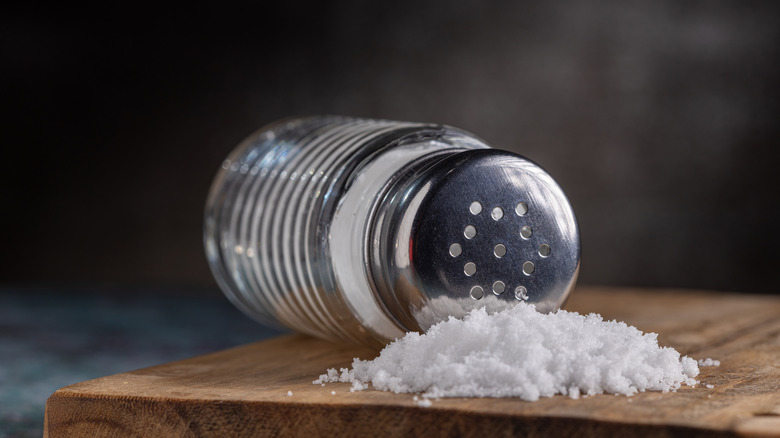The Simple Hack To Stop Salt From Hardening In The Shaker
Picking up a salt shaker at a restaurant, you might notice that the sodium contains lumps and bumps. It's not your imagination. Those larger white pieces are actually rice, and they're a sign the establishment knows the easiest hack in the book. A pinch of the grains prevents salt from hardening.
The lumping that occurs in salt shakers and prevents you from extracting the delicious mineral is caused by contact with water. Salt's crystal structures are quick to bind back together when wet. And since salt attracts the liquid (which is why adding salt to water can help boost hydration), home cooks are fighting an uphill battle.
That's where rice comes in. The starch is famously the go-to fixer for soggy electronic devices, soaked wallets, and other water-damaged items because it's able to absorb moisture. Adding a couple of uncooked grains to your salt shaker prevents the crystals from their natural inclination to clump and cake. Just place a small amount of rice at the bottom of your shaker — though don't do this with a mill or grinder, as it'll gum up the mechanism.
Adding rice to salt shakers
Adding rice is similar to fighting fire with fire. The grain also sucks up liquids, which takes the pressure off salt crystals as you tip them over steaming pots and leave them exposed to the air on humid days. Some home cooks swap in dried beans, coffee, or certain spices to absorb ambient moisture instead, but they might impart an aroma or simply be less effective.
Though any type of rice works, you can apply some kitchen smarts to maximize your moisture absorption. Long-grain and brown varieties take in more water than short-grain and white when cooking. As such, these starches might be a better fit for your shaker. Plus, longer, wider grains will be less likely to slip through and provide unwanted crunch to your meal.
You're not likely to notice a change in taste since you're using only a small serving, but if you add too many, you may find they start to cluster and block the shaker's holes. Technically, you can use this trick across all types (and containers) of salt. But since you're probably taking pinches of the coarser stuff and salting proteins from a distance, rather than relying on the filtering top of a shaker, you'll risk grabbing more than you bargained for if the different grains intermix. You're better off storing cooking salt in a lidded container away from moisture and using your fingers to break up larger pieces as they form.
Cleaning out hardened salt
Most table salt is made with anti-caking agents, which, like rice, combat the clumping effects of a damp kitchen and help keep the mineral flowing. But containers and salt shakers alike fall prey to water's hardening effect over the years as the additives lose strength. That means the best way to combat hardened salt is to use it relatively quickly, within about five years.
If you encounter chunks of salt, try shaking the container vigorously to break up the pieces and pouring it through a fine mesh sieve to salvage the remaining crystals. Some say that you should simply scrap stubborn, stuck-together bits, as the mineral is cheap and widely available, but determined cooks can also put their blender or a mortar and pestle to pulverize the sodium. Since mills and grinders can become clogged when exposed to moisture, we don't recommend placing soggy salt inside.
One of the reasons cooks appreciate iodized sodium's small grains is because they dissolve quickly. When it comes to cleaning up and unsticking shakers, you can take advantage of this quality by filling the vessel with hot water to melt away stuck-on bits. For more stubborn blockages, tackle with dish soap, as well.



